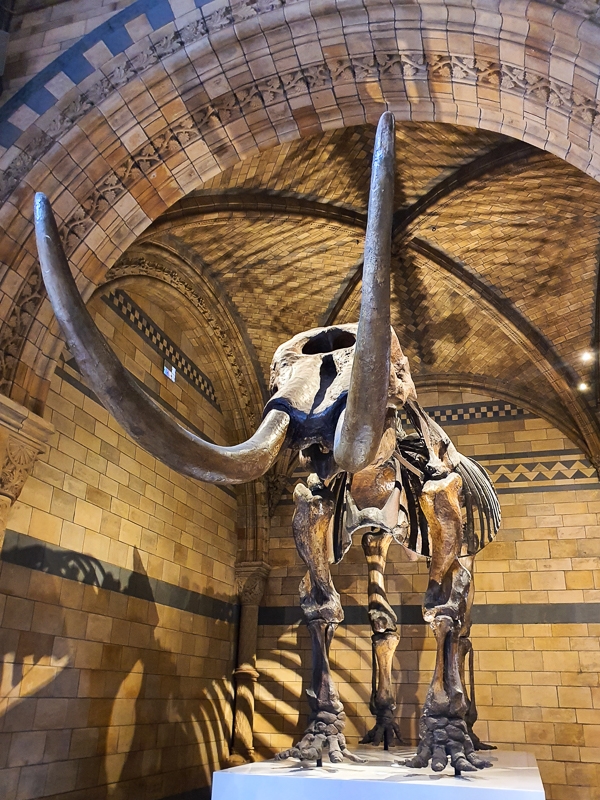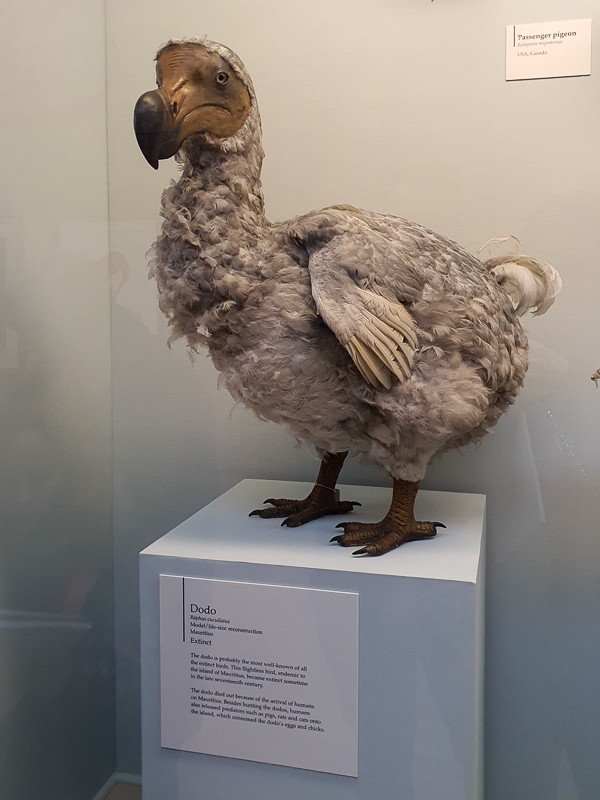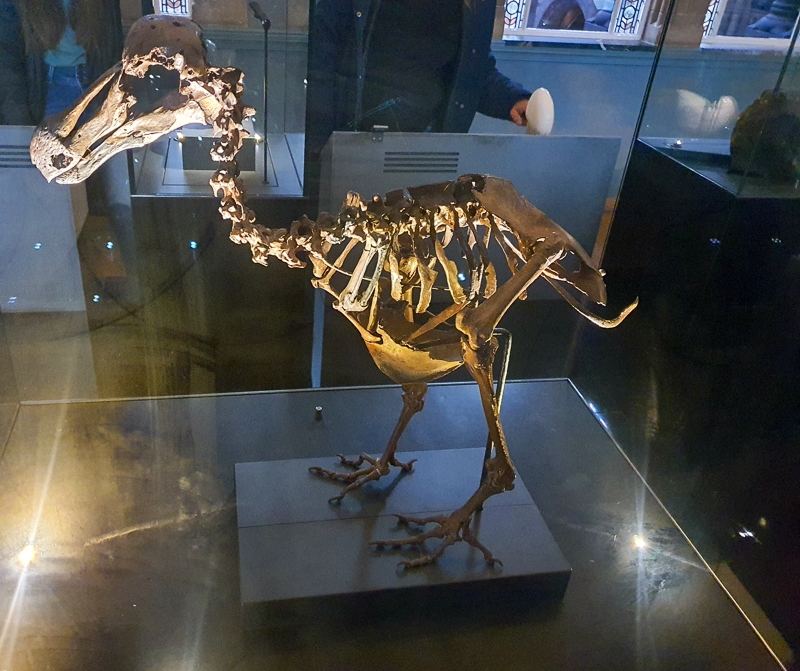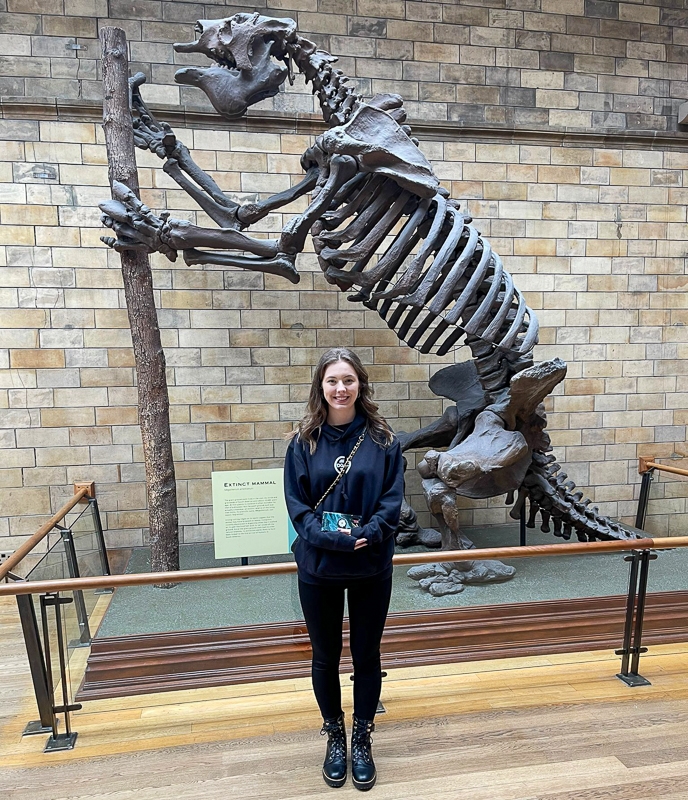DE-EXTINCTION: WILL WE SEE DODOS AGAIN?

American mastodon, Natural History Museum, London. Could mastodons make it to the list of species to bring back?
I'm rather fond of a quirky book that accompanies a 2001 documentary series entitled Extinct. The book explores what we know about several extinct animals and the Channel 4 documentary uses state of the art 3D computer graphics to bring the histories to life. It's truly worth watching - if only to appreciate how far said graphics have come in the past two decades.
The first episode shows CGI dodos running around the forests of Mauritius, occasionally holding their stunted wings out in front of them like a small, omnivorous T-Rex. Among the mind-bending scenes of early '00s computer imagery there's a segment where Dr Beth Shapiro is shaving off a bit of dodo leg bone. 🦤
The DNA in an Oxford University Museum of Natural History dodo specimen was the key to the puzzle of where the dodo belonged. We love organising beings into groups, but for hundreds of years we just couldn't place the dodo.

Dodo at the Natural History Museum, London
Then Shapiro cracked it: the dodo was king of the pigeons. The dodo DNA showed that their nearest relatives are a group of pigeons in south east Asia.
The dodo is a maligned bird. Their name comes from doedaars - literally, 'fat-arse'. Patchy, inconsistent early accounts and over-fed captive birds combined to create impressions that eventually led to the creature becoming a caricature, immortalised in Disney's 1951 Alice in Wonderland as a barrel-shaped idiot.*
Modern scientists think more highly of the dodo. We're beginning to realise that they were, in fact, supremely well adapted to their environment, sitting comfortably at the top of the food chain and not in the least bit stupid.
Now, Shapiro is hoping to resurrect the king of the pigeons, Jurassic Park style.
She's lead paleogeneticist for Colossal Biosciences, a US genetics start-up and self-proclaimed "de-extinction company". And they're not stopping at dodos - they also want to bring back the likes of the woolly mammoth and Tasmanian tiger (both of which were subject to '00s CGI imagination in the Extinct documentary, too).
My use of 'the likes of' above is apt, because these invented creatures won't be actual dodos. They won't have dodo DNA; they'll be part pigeon, part dodo. The team will sequence the dodo DNA and then edit pigeon DNA to get as close to the dodo's as they can.
The idea has its critics, but it's a popular investment. The FT reports that Colossal has received $225 million in investment since it was set up in 2021 and its most recent $150 million funding round was oversubscribed.

A dodo skeleton, Natural History Museum, London
Is it a good idea to build new creatures like the ones that we drove to extinction? Anyone who's watched Jurassic Park (and if you haven't, where have you been?) is probably on the fence. Sure, it got pretty terrifying in the end, but weren't the dinosaurs magnificent?
Anyone who's read about the cane toad (I'll let you off if you haven't) or, indeed, the decline of the dodos (caused, at least in part, by the release of invasive pigs), probably feels nervous about the idea of unleashing a new dodo-pigeon into an ecosystem. Not to mention the fact that the ecosystem in which the dodos lived barely exists anymore (and there are still pigs in all forested parts of Mauritius).
We also don't know much about extinct animals. My odd, beloved book says we know more about the dinosaurs than we do about the dodo. We don't know much about the ecosystem of Mauritius in those days, either.
The solution to rising extinction rates is reducing the colossal impact we're having on the natural world; could resurrecting species that went extinct hundreds of years ago be a distraction from the mission, particularly if we introduce them to a world in which even species more recently adapted to the conditions are struggling to survive the changes humans are causing?
I feel a huge sense of loss when I read about creatures like the dodo, the great auk, woolly mammoth, Tasmanian tiger. It would be so wonderful to meet them again, to treat them better this time.
I'm also broadly supportive of re-introduction programmes. In the UK, we're reintroducing the bison (which was extinct here about 6,000 years ago), the beaver (about 400 years ago), and perhaps even wolves (about 500 years ago). Reintroductions are having positive effects on our ecosystems and are becoming an increasingly important facet of conservation work. So is reintroducing the dodo (which became extinct about 300 years ago) to Mauritius on the path we're already charting?
The problem is, we live in a world where "tech will save the day" continues to be the stick upon which climate change deniers lean, and de-extinction sounds like it might belong in the same category as other risky ideas like geo-engineering or "fertilising" the oceans, which Naomi Klein links to industrial, capitalist non-solutions to the crisis.
I would love to see extinct creatures, and the idea calls to me. But I question if we're doing them a disservice by bringing them back as a shadow of their former selves.

An extinct mammal I'd dearly love to meet: the giant ground sloth
*In Lewis Carroll's book, written almost a century earlier, the dodo is well-spoken, and arguably the character that makes the most sense in a senseless story. In the book, the dodo suggests that the animals run on dry ground to dry off, and it works. Sir John Tenniel's illustrations show a sophisticated bird with royal blue feathers, a little over-plump and inexplicably sporting hands (complete with matching royal blue sleeves), but nowehere near as slanderous as Disney's version. In the film, the dodo is a pompous leader, heating himself with a fire while he commands the other animals to run in circles to dry off in a place where the waves continue to soak them.
Share with your friends
Subscribe to learn more
Join me in exploring our natural world and cultural heritage as we learn how to protect and restore it. Get notified on my latest posts and a monthly newsletter on wider conversation topics for us to chat about.
Recent Posts
If you enjoyed this one, then you might like these too.